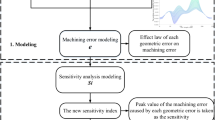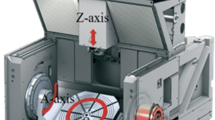Abstract
This paper focuses on optimization of kinematic chain to reduce force-induced error in the scheme design phase of a five-axis machine tool. After conducting process planning on the machining target, local deformation of motion units in cutting positions is considered using a geometric way. A mathematical model is then established describing the influence of local deformation error on the general machining error through homogeneous transformation matrices. Conceptual model of the machine tool is constructed to obtain deformation distribution using static FEA. Error sensitivity coefficients are then calculated and compared among all alternative kinematic chains to select the optimized scheme. The proposed method is verified through a designing example of a five-axis vertical machining center. The optimized kinematic chain could lower the magnitude of deformation sensitivities by 9.69% and increase error equalization variance by 71.25% compared to the conventional method.











Similar content being viewed by others
References
Gadalla, M., & Xue, D. (2017). Optimal design of a reconfigurable machine tool considering machine configurations and configuration changes. Procedia CIRP, 60, 446–451. https://doi.org/10.1016/j.procir.2017.01.044.
López De Lacalle, L. N., & Lamikiz, A. (2009). Machine tools for high performance machining. London: Springer. https://doi.org/10.1007/978-1-84800-380-4.
Lekhmus, M. Y., Fetsak, S. I., & Amirov, R. F. (2017). Structural synthesis of machine-tool configurations. Russian Engineering Research, 37(4), 335–337. https://doi.org/10.3103/S1068798X17040153.
Gönnheimer, P., Hillenbrand, J., Betz-Mors, T., Bischof, P., Mohr, L., & Fleischer, J. (2019). Auto-configuration of a digital twin for machine tools by intelligent crawling. In Production at the leading edge of technology, pp. 543–552. https://doi.org/10.1007/978-3-662-60417-5_54.
Chen, W., Luo, X., Su, H., & Wardle, F. (2016). An integrated system for ultra-precision machine tool design in conceptual and fundamental design stage. International Journal of Advanced Manufacturing Technology, 84(5–8), 1177–1183. https://doi.org/10.1007/s00170-015-7780-0.
Anand, K. V., & Udhayakumar, S. (2019). Design of adaptable pin configuration machine bed optimized with genetic approach for sheet metal cutting process. Journal of Intelligent Manufacturing, 30(3), 1319–1333. https://doi.org/10.1007/s10845-017-1327-1.
Wang, G., Wang, S., Huang, S., Shang, X., & Yan, Y. (2020). Feature-driven design of reconfigurable machine tool configurations. In Reconfigurable manufacturing systems: From design to implementation, pp. 89–122. https://doi.org/10.1007/978-3-030-28782-5_5.
Bohez, E. L. (2002). Five-axis milling machine tool kinematic chain design and analysis. International Journal of Machine Tools and Manufacture, 42(4), 505–520. https://doi.org/10.1016/S0890-6955(01)00134-1.
Wu, B. C., Young, G. S., & Huang, T. Y. (2000). Application of a two-level optimization process to conceptual structural design of a machine tool. International Journal of Machine Tools and Manufacture, 40(6), 783–794. https://doi.org/10.1016/S0890-6955(99)00113-3.
Huo, D., Cheng, K., & Wardle, F. (2010). Design of a five-axis ultra-precision micro-milling machine-UltraMill. Part 1: Holistic design approach, design considerations and specifications. International Journal of Advanced Manufacturing Technology, 47(9–12), 867–877. https://doi.org/10.1007/s00170-009-2128-2.
Tutunea-Fatan, O. R., & Bhuiya, M. S. H. (2011). Comparing the kinematic efficiency of five-axis machine tool configurations through nonlinearity errors. CAD Computer Aided Design, 43(9), 1163–1172. https://doi.org/10.1016/j.cad.2011.05.003.
Wang, G., Shang, X., Yan, Y., Allen, J. K., & Mistree, F. (2018). A tree-based decision method for the configuration design of reconfigurable machine tools. Journal of Manufacturing Systems, 49, 143–162. https://doi.org/10.1016/j.jmsy.2018.07.003.
Wang, Y., Zhang, G., & Han, L. (2019). A methodology of setting module groups for the design of reconfigurable machine tools. International Journal of Advanced Manufacturing Technology, 104(5–8), 2133–2147. https://doi.org/10.1007/s00170-019-03337-6.
Pham, V. D., & Song, C. K. (2018). A novel dynamic model for multiple configurations of machine tools using a coordinate transformation method. International Journal of Advanced Manufacturing Technology, 95(1–4), 27–42. https://doi.org/10.1007/s00170-017-1186-0.
Zhang, C., Jiang, P., Cheng, K., Xu, X. W., & Ma, Y. (2016). Configuration design of the add-on cyber-physical system with CNC machine tools and its application perspectives. Procedia CIRP, 56, 360–365. https://doi.org/10.1016/j.procir.2016.10.040.
Lajili, M., Chanal, H., Bouzgarrou, C., & Duc, E. (2019). A new approach for machine-tool architecture selection at preliminary design stage. In Lecture Notes in Mechanical Engineering, pp. 95–104. https://doi.org/10.1007/978-3-030-12346-8_10.
Echerfaoui, Y., El Ouafi, A., & Chebak, A. (2018). Experimental investigation of dynamic errors in coordinate measuring machines for high speed measurement. International Journal of Precision Engineering and Manufacturing, 19(8), 1115–1124. https://doi.org/10.1007/s12541-018-0132-x.
Ibaraki, S., Yoshida, I., & Asano, T. (2019). A machining test to identify rotary axis geometric errors on a five-axis machine tool with a swiveling rotary table for turning operations. Precision Engineering, 55, 22–32. https://doi.org/10.1016/j.precisioneng.2018.08.003.
Wang, J., Cheng, C., & Li, H. (2020). A novel approach to separate geometric error of the rotary axis of multi-axis machine tool using laser tracker. International Journal of Precision Engineering and Manufacturing,. https://doi.org/10.1007/s12541-020-00329-5.
Schmitt, R., & Peterek, M. (2015). Traceable measurements on machine tools-thermal influences on machine tool structure and measurement uncertainty. Procedia CIRP, 33, 576–580. https://doi.org/10.1016/j.procir.2015.06.087.
Liu, S., & Lin, M. (2019). Thermal-mechanical coupling analysis and experimental study on CNC machine tool feed mechanism. International Journal of Precision Engineering and Manufacturing, 20(6), 993–1006. https://doi.org/10.1007/s12541-019-00069-1.
Pomares, J., Jara, C. A., Pérez, J., & Torres, F. (2015). Direct visual serving framework based on optimal control for redundant joint structures. International Journal of Precision Engineering and Manufacturing, 16(2), 267–274. https://doi.org/10.1007/s12541-015-0035-z.
Lyu, D., Liu, Q., Liu, H., & Zhao, W. (2020). Dynamic error of CNC machine tools: A state-of-the-art review. International Journal of Advanced Manufacturing Technology, 106(5–6), 1869–1891. https://doi.org/10.1007/s00170-019-04732-9.
Xu, P., Li, B., Cheung, C. F., & Zhang, J. F. (2017). Stiffness modeling and optimization of a 3-DOF parallel robot in a serial-parallel polishing machine. International Journal of Precision Engineering and Manufacturing, 18(4), 497–507. https://doi.org/10.1007/s12541-017-0060-1.
Duong, T. H., & Kim, H. C. (2015). Deformation analysis of rectangular channel structures in micro pattern machining. International Journal of Precision Engineering and Manufacturing, 16(4), 619–627. https://doi.org/10.1007/s12541-015-0083-4.
Pan, Y., & Xu, L. (2015). Vibration analysis and experiments on electrochemical micro-machining using cathode vibration feed system. International Journal of Precision Engineering and Manufacturing, 16(1), 143–149. https://doi.org/10.1007/s12541-015-0018-0.
Sagris, D., Davids, C., Stergianni, E., Tsiafis, C., & Tsiafis, I. (2017). Computational and experimental analysis of machine tool vibrations in micro-milling. In MATEC web of conferences, Vol. 112. https://doi.org/10.1051/matecconf/201711201022
Fesperman, R. R., Moylan, S. P., Vogl, G. W., & Donmez, M. A. (2015). Reconfigurable data driven virtual machine tool: Geometric error modeling and evaluation. CIRP Journal of Manufacturing Science and Technology, CIRP, 10, 120–130. https://doi.org/10.1016/j.cirpj.2015.03.001.
Wang, J. D., Wang, Q. J., & Li, H. T. (2019). The method of geometric error measurement of NC machine tool based on the principle of space vector’s direction measurement. International Journal of Precision Engineering and Manufacturing, 20(4), 511–524. https://doi.org/10.1007/s12541-019-00062-8.
Gaska, P., Gaska, A., & Gruza, M. (2017). Challenges for modeling of five-axis coordinate measuring systems. Applied Sciences (Switzerland), 7(8), 803. https://doi.org/10.3390/app7080803.
Ibaraki, S., & Yoshida, I. (2017). A five-axis machining error simulator for rotary-axis geometric errors using commercial machining simulation software. International Journal of Automation Technology, 11(2), 179–187. https://doi.org/10.20965/ijat.2017.p0179.
Flynn, J. M., Muelaner, J. E., Dhokia, V., & Newman, S. T. (2016). Improving error models of machine tools with metrology data. In Procedia CIRP, Elsevier B.V., Vol. 52, pp. 204–209. https://doi.org/10.1016/j.procir.2016.07.053
Viprey, F., Nouira, H., Lavernhe, S., & Tournier, C. (2016). Novel multi-feature bar design for machine tools geometric errors identification. Precision Engineering, 46, 323–338. https://doi.org/10.1016/j.precisioneng.2016.06.002.
Zhong, X., Liu, H., Mao, X., & Li, B. (2019). An optimal method for improving volumetric error compensation in machine tools based on squareness error identification. International Journal of Precision Engineering and Manufacturing, 20(10), 1653–1665. https://doi.org/10.1007/s12541-019-00191-0.
Yan, H., Cao, Y., & Yang, J. (2016). Statistical tolerance analysis based on good point set and homogeneous transform matrix. Procedia CIRP, 43, 178–183. https://doi.org/10.1016/j.procir.2016.02.042.
Lee, K. I., Lee, J. C., & Yang, S. H. (2018). Optimal on-machine measurement of position-independent geometric errors for rotary axes in five-axis machines with a universal head. International Journal of Precision Engineering and Manufacturing, 19(4), 545–551. https://doi.org/10.1007/s12541-018-0066-3.
Liu, Z., Xu, J., Cheng, Q., Zhao, Y., Pei, Y., & Yang, C. (2018). Trajectory planning with minimum synthesis error for industrial robots using screw theory. International Journal of Precision Engineering and Manufacturing, 19(2), 183–193. https://doi.org/10.1007/s12541-018-0021-3.
Xi, X. C., Liu, H. D., Chen, H., Ye, L., & Zhao, W. S. (2019). Kinematics for a six-axis EDM machine by screw theory and its application in feedrate planning in EDM for shrouded blisks. International Journal of Advanced Manufacturing Technology, 105(1–4), 1457–1467. https://doi.org/10.1007/s00170-019-04311-y.
Wang, K., Du, S., & Xi, L. (2020). Three-dimensional tolerance analysis modelling of variation propagation in multi-stage machining processes for general shape workpieces. International Journal of Precision Engineering and Manufacturing, 21(1), 31–44. https://doi.org/10.1007/s12541-019-00202-0.
Park, D. K., Lee, G. I., Gao, J. C., & Kim, J. Y. (2016). Research on the design of the ultra-high-precision positioning control error compensation. International Journal of Precision Engineering and Manufacturing, 17(10), 1351–1358. https://doi.org/10.1007/s12541-016-0160-3.
Xiang, S., Deng, M., Li, H., Du, Z., & Yang, J. (2019). Volumetric error compensation model for five-axis machine tools considering effects of rotation tool center point. International Journal of Advanced Manufacturing Technology, 102(9–12), 4371–4382. https://doi.org/10.1007/s00170-019-03497-5.
Xia, C., Wang, S., Ma, C., Wang, S., & Xiao, Y. (2020). Crucial geometric error compensation towards gear grinding accuracy enhancement based on simplified actual inverse kinematic model. International Journal of Mechanical Sciences, 169(November), 105319. https://doi.org/10.1016/j.ijmecsci.2019.105319.
Groos, L., Held, C., Keller, F., Wendt, K., Franke, M., & Gerwien, N. (2020). Mapping and compensation of geometric errors of a machine tool at different constant ambient temperatures. Precision Engineering, 63, 10–17. https://doi.org/10.1016/j.precisioneng.2020.01.001.
Tang, H., Zhang, Z., Li, C., & Ko, T. J. (2019). A geometric error modeling method and trajectory optimization applied in laser welding system. International Journal of Precision Engineering and Manufacturing, 20(8), 1423–1433. https://doi.org/10.1007/s12541-019-00151-8.
Li, J., Xie, F., & Liu, X. J. (2016). Geometric error modeling and sensitivity analysis of a five-axis machine tool. International Journal of Advanced Manufacturing Technology, 82(9–12), 2037–2051. https://doi.org/10.1007/s00170-015-7492-5.
Schleich, B., & Wartzack, S. (2018). An approach to the sensitivity analysis in variation simulations considering form deviations. Procedia CIRP, 75, 273–278. https://doi.org/10.1016/j.procir.2018.03.314.
Cheng, Q., Feng, Q., Liu, Z., Gu, P., & Zhang, G. (2016). Sensitivity analysis of machining accuracy of multi-axis machine tool based on POE screw theory and Morris method. International Journal of Advanced Manufacturing Technology, 84(9–12), 2301–2318. https://doi.org/10.1007/s00170-015-7791-x.
Ben Abdessalem, A., & El-Hami, A. (2014). Global sensitivity analysis and multi-objective optimisation of loading path in tube hydroforming process based on metamodelling techniques. International Journal of Advanced Manufacturing Technology, 71(5–8), 753–773. https://doi.org/10.1007/s00170-013-5518-4.
Lagerwall, G., Kiker, G., Muñoz-Carpena, R., & Wang, N. (2014). Global uncertainty and sensitivity analysis of a spatially distributed ecological model. Ecological Modelling, 275, 22–30. https://doi.org/10.1016/j.ecolmodel.2013.12.010.
Acknowledgements
The work presented in this article is funded by National Natural Science Foundation of China (Grant No. 51675478) and National Science Foundation of Zhejiang Province (Grant No. LY18E050001).
Author information
Authors and Affiliations
Corresponding author
Ethics declarations
Conflict of interest
The authors declare that they have no conflict of interest.
Additional information
Publisher's Note
Springer Nature remains neutral with regard to jurisdictional claims in published maps and institutional affiliations.
Rights and permissions
About this article
Cite this article
Zhang, S., He, C., Liu, X. et al. Kinematic Chain Optimization Design Based on Deformation Sensitivity Analysis of a Five-Axis Machine Tool. Int. J. Precis. Eng. Manuf. 21, 2375–2389 (2020). https://doi.org/10.1007/s12541-020-00421-w
Received:
Revised:
Accepted:
Published:
Issue Date:
DOI: https://doi.org/10.1007/s12541-020-00421-w




